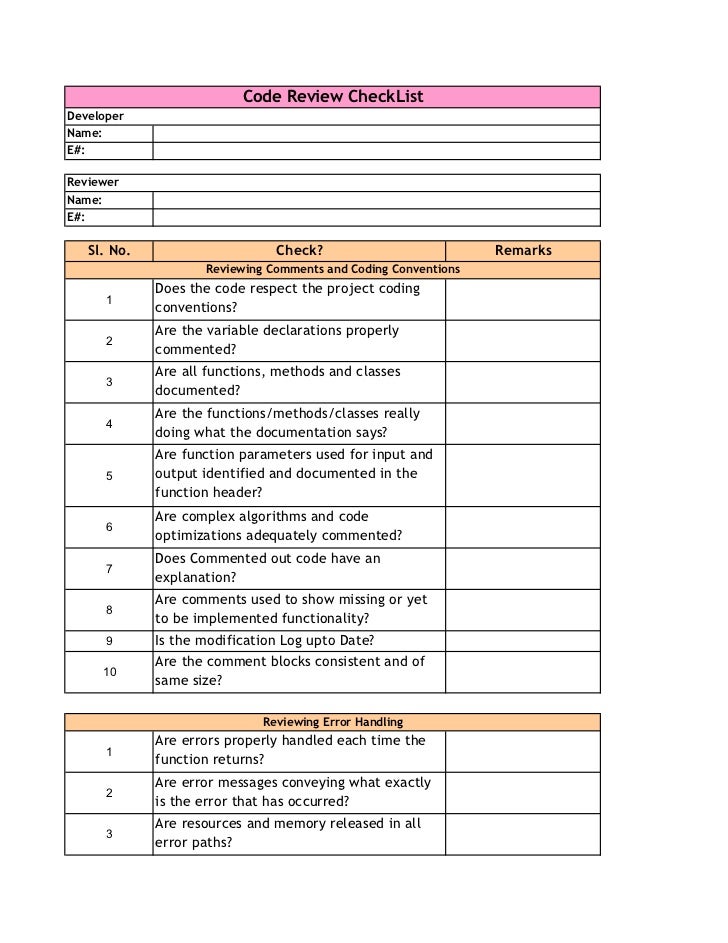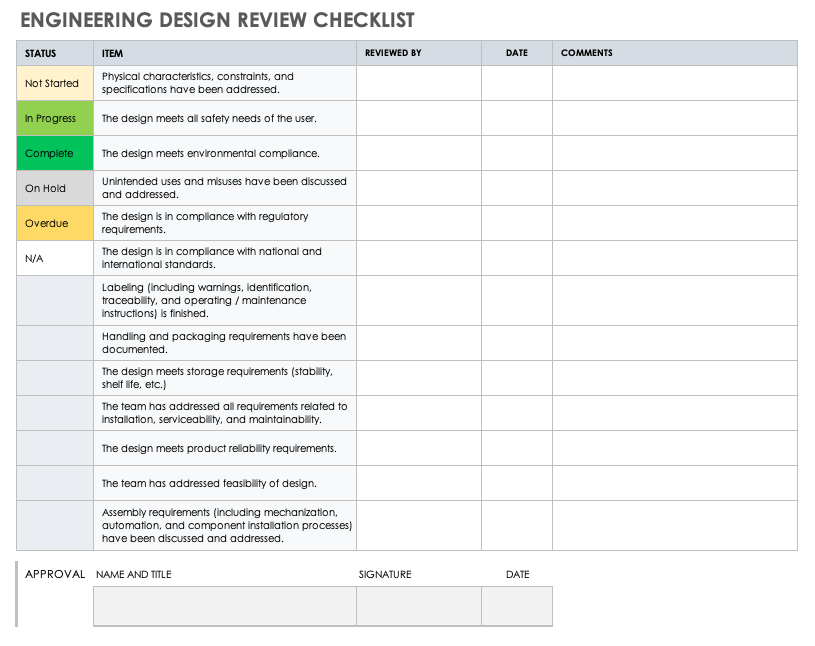
It is important–and sometimes, required by law–to set up and manage a personnel (or employee) filing system. However, it's important to remember there is not just one file per employee.
- Some personnel files are used for helping managers make employee-related decisions.
- Other files are highly confidential and can contain information protected by privacy laws.
A compliance checklist example is a specific set of questions used to test whether a product or service is compliant. Business executives often use these queries to test how a product or a specific service complies with specific standards, especially in areas that are usually difficult to test. Review File Documents Department Letter (2016-17 CALL, page 32) (and Acceleration (Page 8-9). Review additions, deletions, corrections, etc., to the departmental recommendation and/or the contents of the file for impact on documented departmental review. (Major changes in the file may result in a vote change from negative to positive or positive. A document management configuration of TMF document types, trial master file checklist templates, metadata, version control, lifecycle management, routes and user roles for all TMF artifacts A secure collaboration environment for sharing and exchanging clinical trial master file content with both internal teams and external contributors (i.e.
Tenant File Review Checklist
Case File Checklist. Place this checklist the front of each participant case file. Use the checkboxes to indicate whether the form is in the file. The comments box can be used to record notes about the form, as appropriate. This checklist includes items that are common to OHHLHC grant program. Use this checklist in conjunction with the Delegated Examining Program Review checklist and the Delegated Examining Operations Handbook (DEOH). Delegated examining authority applies to filling temporary, term, and permanent competitive positions (see DEOH 2-A).
Therefore, a personnel filing system can't be a one-size-fits-all approach, as there are certain types of information related to employees that are highly personal (medical, for instance) that should be maintained in a system separate from that which is used for personnel decision purposes.
Another factor in determining what types of files to manage relates the size of the company. For instance, some companies with less than 50 employees may not be required to maintain a specific type of form, what those with 51 are.
So think of a personnel filing system as being several types of files.
- Certain employee files contain information that laws and regulations require; and that they require confidentiality. This protected information can only be seen by personnel who are designated to see it for specific, government-approved reasons. Such files can relate to benefits, salary, medical conditions, and legal issues.
- The other file, and the one most typically referred to as the general 'personnel file,' contains information related exclusively to the employee's performance on the job that can be seen by the employee's supervisory personnel.
Why have records at all?
There are several basic reasons for maintaining files related to each employee:
Resident File Checklist
- They aid in promotion or layoff decisions
- They provide a means to track activities related to such things as training, vacations, accolades, conflicts
- They are necessary to comply with various local, state and federal laws and regulations
- They provide records of activities, conversations, reviews, etc., that can be important in reducing the potential liability if an employee is laid off



What stays and what goes?
The following should, and should not, be included in a basic employment file.
Should be included
Job description (present, past positions)
Resumé
Records relating to job offers, promotion, demotion, transfer, layoff, rates of pay and other forms of compensation, and education and training records
Records relating to other employment practices (including policy acknowledgments and agreements)
Letters of recognition
Disciplinary notices or documents
Performance evaluations and goal setting records
Termination records
Employment Application
Orientation Checklist
Emergency Contact Information
Employees Withholding Allowance
Certificate W-4
State Specific Employees Withholding Allowance Certificate, if applicable
Copy of Driver's License, if required for the position
Signed Receipt of Employee Handbook and Employment-at-will Statement
Change in Personal Data Form
Performance Evaluations
Position/Rate Change Forms
Record of Disciplinary Action (Verbal and Written Warnings), if applicable
Absentee Record
Requests for Time Off
Training Requests
Documentation of Training
Documentation of Certification and/or License (if applicable)
Requests to Review Personnel File
Resignation Statement
It is important–and sometimes, required by law–to set up and manage a personnel (or employee) filing system. However, it's important to remember there is not just one file per employee.
- Some personnel files are used for helping managers make employee-related decisions.
- Other files are highly confidential and can contain information protected by privacy laws.
A compliance checklist example is a specific set of questions used to test whether a product or service is compliant. Business executives often use these queries to test how a product or a specific service complies with specific standards, especially in areas that are usually difficult to test. Review File Documents Department Letter (2016-17 CALL, page 32) (and Acceleration (Page 8-9). Review additions, deletions, corrections, etc., to the departmental recommendation and/or the contents of the file for impact on documented departmental review. (Major changes in the file may result in a vote change from negative to positive or positive. A document management configuration of TMF document types, trial master file checklist templates, metadata, version control, lifecycle management, routes and user roles for all TMF artifacts A secure collaboration environment for sharing and exchanging clinical trial master file content with both internal teams and external contributors (i.e.
Tenant File Review Checklist
Case File Checklist. Place this checklist the front of each participant case file. Use the checkboxes to indicate whether the form is in the file. The comments box can be used to record notes about the form, as appropriate. This checklist includes items that are common to OHHLHC grant program. Use this checklist in conjunction with the Delegated Examining Program Review checklist and the Delegated Examining Operations Handbook (DEOH). Delegated examining authority applies to filling temporary, term, and permanent competitive positions (see DEOH 2-A).
Therefore, a personnel filing system can't be a one-size-fits-all approach, as there are certain types of information related to employees that are highly personal (medical, for instance) that should be maintained in a system separate from that which is used for personnel decision purposes.
Another factor in determining what types of files to manage relates the size of the company. For instance, some companies with less than 50 employees may not be required to maintain a specific type of form, what those with 51 are.
So think of a personnel filing system as being several types of files.
- Certain employee files contain information that laws and regulations require; and that they require confidentiality. This protected information can only be seen by personnel who are designated to see it for specific, government-approved reasons. Such files can relate to benefits, salary, medical conditions, and legal issues.
- The other file, and the one most typically referred to as the general 'personnel file,' contains information related exclusively to the employee's performance on the job that can be seen by the employee's supervisory personnel.
Why have records at all?
There are several basic reasons for maintaining files related to each employee:
Resident File Checklist
- They aid in promotion or layoff decisions
- They provide a means to track activities related to such things as training, vacations, accolades, conflicts
- They are necessary to comply with various local, state and federal laws and regulations
- They provide records of activities, conversations, reviews, etc., that can be important in reducing the potential liability if an employee is laid off
What stays and what goes?
The following should, and should not, be included in a basic employment file.
Should be included
Job description (present, past positions)
Resumé
Records relating to job offers, promotion, demotion, transfer, layoff, rates of pay and other forms of compensation, and education and training records
Records relating to other employment practices (including policy acknowledgments and agreements)
Letters of recognition
Disciplinary notices or documents
Performance evaluations and goal setting records
Termination records
Employment Application
Orientation Checklist
Emergency Contact Information
Employees Withholding Allowance
Certificate W-4
State Specific Employees Withholding Allowance Certificate, if applicable
Copy of Driver's License, if required for the position
Signed Receipt of Employee Handbook and Employment-at-will Statement
Change in Personal Data Form
Performance Evaluations
Position/Rate Change Forms
Record of Disciplinary Action (Verbal and Written Warnings), if applicable
Absentee Record
Requests for Time Off
Training Requests
Documentation of Training
Documentation of Certification and/or License (if applicable)
Requests to Review Personnel File
Resignation Statement
Should NOT be included in a basic employment file
| There should be one file per employee. DO NOT mix together into a shared file the payroll file documents for more than one employee.
| The following documents belong in a SEPARATE file(s) and SHOULD NOT BE accessible to supervisors who are seeking information about the employee's work performance. The information found in these documents are protected under privacy laws and belong with other guarded, confidential documentation.
EEO/invitation to self-identify disability or veteran status records.
Interview notes and employment test results.
Reference/background checks.
Drug test results.
Immigration (I-9) forms.
Medical/insurance records (medical questionnaires, benefit enrollment forms and benefit claims, doctors notes, accommodation requests, and leave of absence records).
Child support/garnishments.
Litigation documents.
Workers' compensation claims.
Investigation records. (Only any relevant disciplinary action, counseling or other direct communications would be placed in the employee's personnel file.)
Requests for employment/payroll verification.
Benefits File (Confidential)
( | There should be one file per employee. DO NOT mix together into a shared file of benefits documents for more than one employee.)
Benefits Declination Form
Health, Dental, Vision, and/or Pharmacy Insurance Enrollment Forms
Other Insurance Enrollment Forms (Life Insurance, STD, LTD, etc)
Flexible Spending Account Forms
Election Form/Compensation Reduction Agreement
Employee Direct Deposit Signup Form
Claims
Enrollment Form, Retirement Forms, Profit Sharing Forms
S125 Premium Only Plan Forms
Beneficiary Designation Form
COBRA or State Continuation paperwork, if applicable
Payroll File (Confidential)
( | There should be one file per employee. DO NOT mix together into a shared file the payroll file documents for more than one employee.)
Direct Deposit Authorization
Payroll Deduction Authorization Forms
Overtime Requests, if applicable
Time Sheets
Employee Expense Report
Auto Mileage Reimbursement Vouchers
Garnishments/Income Executions
Requests for Pay Advances
More Confidential Files
( | There should be one file per employee. DO NOT mix together into a shared file the payroll file documents for more than one employee.)
Documentation of Investigations
Lawsuit or DOL/EEOC investigation correspondence
EEOC and Affirmative Action Data
Background Check and Drug Testing Results
OSHA Forms
Employee Incident Report
Medical Information
FMLA Forms
Employee Request for Family Medical Leave
Certification of Health Care Provider
Family Medical Leave Periodic Reports
Family Medical Leave Return to Work Certification
Disability and/or Workers' Compensation Claim Forms
Accommodation Requests
Sources: SHRM.org, Nolo.com, Paychex.com (PDF).
Related Articles
Mortgage Processor File Review Checklist
A SmallBusiness.com checklist of things you need in a small business office kitchen.
Maybe your office only has paper cuts and bruised egos, but it's still a smart…
To prevent violations of employment laws, here are seven questions to avoid any time, anywhere,…
